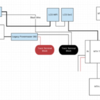So I've already melted a red in post cover on the TIU. So before I mess anything else up, can someone please help me finish this wiring diagram? I have Lionel Legacy working perfectly with two 180w Powerhouses into a Legacy Powermaster 360. I am able to run legacy and conventional with the flip of a switch. I have a Ser2 and all other items in this diagram.
My question is what sort of chokes (what is a choke?) and fuses or other specialty items do i need and where do they go. This is a partial wiring diagram i am building. I have Barry's book and it is a greeat book. Just not sure how to get it fully implemented. Do i use a wall wart for the TIU power and wire it passively? Etc. Etc.
Here is the diagram i am making.
No damage besides the melted cap on the TIU. The wires from the TIU are left unattached until i know where to put them and what else i need to add.
Thanks for any and all help!






